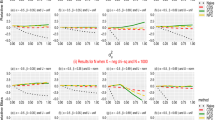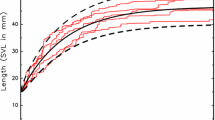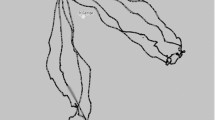Abstract
Much of what is known about bottle nose dolphin (Tursiops truncatus) anatomy and physiology is based on necropsies from stranding events. Measurements of total body length, total body mass, and age are used to estimate growth. It is more feasible to retrieve and transport smaller animals for total body mass measurement than larger animals, introducing a systematic bias in sampling. Adverse weather events, volunteer availability, and other unforeseen circumstances also contribute to incomplete measurement. We have developed a Bayesian mixture model to describe growth in detected stranded animals using data from both those that are fully measured and those not fully measured. Our approach uses a shared random effect to link the missingness mechanism (i.e. full/partial measurement) to distinct growth curves in the fully and partially measured populations, thereby enabling drawing of strength for estimation. We use simulation to compare our model to complete case analysis and two common multiple imputation methods according to model mean square error. Results indicate that our mixture model provides better fit both when the two populations are present and when they are not. The feasibility and utility of our new method is demonstrated by application to South Carolina strandings data.


Similar content being viewed by others
References
Carpenter JR, Kenward MG, Vansteelandt S (2006) A comparison of multiple imputation and doubly robust estimation for analyses with missing data. J R Stat Soc 169(3):3798–3813
Clayton D, Spiegelhalter D, Dunn G, Pickles A (1998) Analysis of longitudinal binary data from multi-phase sampling (with discussion). J R Stat Soc Series B Stat Methodol 60(1):71–87
Dempster AP, Laird NM, Rubin DB (1977) Maximum likelihood from incomplete data via the EM algorithm. J R Stat Soc Series B Stat Methodol 39(1):1–38
Dong Y, Peng CJ (2013) Principled missing data methods for researchers. SpringerPlus 2(1):222
Gelman A (2006) Prior distributions for variance parameters in hierarchical models. Bayesian Anal 1:1–19
Gelman A, Rubin DB (1992) Inference from iterative simulation using multiple sequences. Stat Sci 7(4):457–472
Geman S, Geman D (1984) Stochastic relaxation, Gibbs distributions, and the Bayesian restoration of images. IEEE Trans Pattern Anal Mach Intell 6(6):721–741
Hoffman RJ (1991) History, goals and achievements of the regional marine mammal stranding network. In: Reynolds JE, Odell DK (eds) Marine Mammal Strandings in the United States, pp 7–17, nOAA Technical Report NMFS 98. http://www.nmfs.noaa.gov/publications.htm
Hohn A, Scott M, Wells R, Sweeney J, Irvine A (1989) Growth layers in teeth from free-ranging, known-age bottlenose dolphins. Mar Mamm Sci 5:315–342
Horvitz DG, Thompson DJ (1952) A generalization of sampling without replacement from a finite universe. J Am Stat Assoc 47:663–685
Kang JDY, Schafer JL (2007) Demystifying double robustness: a comparison of alternative strategies for estimating a population mean from incomplete data. Stat Sci 22(4):523–539
Little RJA, Schluchter MD (1985) Maximum likelihood estimation for mixed continuous and categorical data with missing values. Biometrika 72(3):497–512
Mattson MC, Mullin KD, Ingram GW, Hoggard W (2006) Age structure and growth of the bottlenose dolphin (Tursiops truncatus) from strandings in the Mississippi Sound region of the north-central Gulf of Mexico from 1986 to 2003. Mar Mamm Sci 22(3):654–666
McFee W, Schwacke J, Stolen M, Mullin K, Schwacke L (2010) Investigation of growth phases for bottlenose dolphins using a Bayesian modeling approach. Mar Mamm Sci 26:67–85
Mead JG, Potter CW (1995) Recognizing two populations of the bottlenose dolphin (Tursiops truncatus) off the Atlantic coast of North America: Morphological and ecological considerations. Int Mar Biol Res Inst: IBI Reports 5:31–44
MMPA (2007) The Marine Mammal Protection Act (MMPA) of 1972 as Amended 2007. Marine Mammal Commission. 4340 East-West Highway, Bethesda, MD 20910. (1972) http://www.nmfs.noaa.gov/pr/pdfs/laws/mmpa.pdf
Robins JM, Rotnitzky A (1995) Semiparametric efficiency in multivariate regression models with missing data. J Am Stat Assoc 90:122–129
Robins JM, Rotnitzky A (2001) Comment on “Inference for semiparametric models: some questions and an answer,” by P. J. Bickel and J. Kwon. Stat Sin 11:920–936
Robins JM, Rotnitzky A, Zhao LP (1994) Estimation of regression coefficients when some regressors are not always observed. J AmStat Assoc 89:846–866
Robins JM, Rotnitzky A, Zhao LP (1995) Analysis of semiparametric regression models for repeated outcomes in the presence of missing data. J Am Stat Assoc 90:106–121
Rotnitzky A, Robins JM, Scharfstein DO (1998) Semiparametric regression for repeated outcomes with ignorable nonresponse. J Am Stat Assoc 93:1321–1339
Rubin DB (1976) Inference and missing data. Biometrika 63:581–592
Shotwell ME, McFee W, Slate EH (2010) Estimating Gompertz growth curves from marine mammal strandings in the presence of missing data. Int J Ecol Econ Stat 19:32–46
Stolen MK, Odell DK, Barros NB (2002) Growth of bottlenose dolphins (Tursiops truncatus) from the Indian River Lagoon system, Florida, USA. Mar Mamm Sci 18(2):348–357
Turner JP, Clark LS, Haubold EM, Worthy GAJ, Cowan DF (2006) Organ weights and growth profiles in bottlenose dolphins (Tursiops truncatus) from the Northwestern Gulf of Mexico. Aquat Mamm 32(1):46–57
Van der Laan MJ, Robins JM (2003) Unified Methods for Censored Longitudinal Data and Causality. Springer, New York
Acknowledgments
We thank members of the NOS Coastal Stranding Assessments Program operating under Section 109(h) of the Marine Mammal Protection Act. Many thanks to stranding volunteers and staff members, the SCDNR, and Coastal Carolina University for stranding participation.
Author information
Authors and Affiliations
Corresponding author
Additional information
Handling Editor: Pierre Dutilleul.
This project was funded in part by the National Institute of General Medical Sciences (NIH/NIGMS 1T32GM074934) training grant ‘Biostatistics Training for Basic Biomedical Research’ and NSF grant DMS-0604666 (Slate).
Appendices
Appendix
Full conditional posterior distributions for all model parameters.
NOAA disclaimer
This publication does not constitute an endorsement of any commercial product or intend to be an opinion beyond scientific or other results obtained by the National Oceanic and Atmospheric Administration (NOAA). No reference shall be made to NOAA, or this publication furnished by NOAA, to any advertising or sales promotion which would indicate or imply that NOAA recommends or endorses any proprietary product mentioned herein, or which has as its purpose an interest to cause the advertised product to be used or purchased because of this publication
Rights and permissions
About this article
Cite this article
Shotwell, M.E., McFee, W.E. & Slate, E.H. A Bayesian mixture model for missing data in marine mammal growth analysis. Environ Ecol Stat 23, 585–603 (2016). https://doi.org/10.1007/s10651-016-0355-x
Received:
Revised:
Published:
Issue Date:
DOI: https://doi.org/10.1007/s10651-016-0355-x




